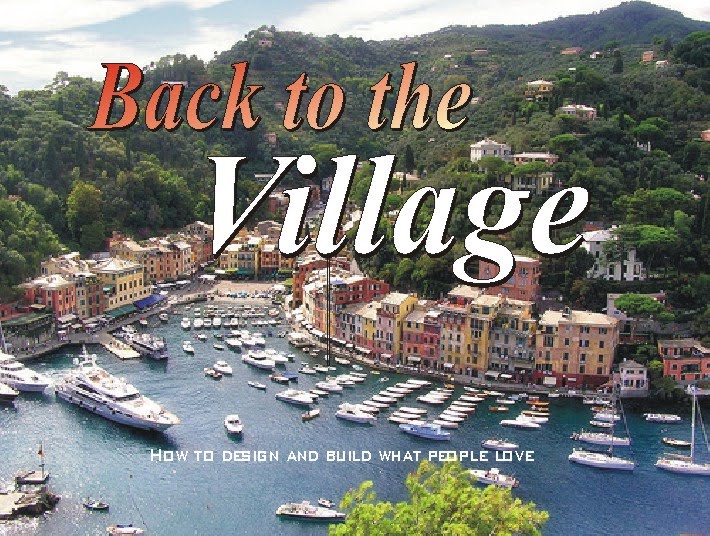Seaside is a planned resort community on the Florida panhandle roughly midway between Fort Walton Beach and Panama City, It was designed by planners Andres Duany and Elizabeth Plater-Zybeck.
The community is often cited as the first New Urbanist development. At the time of Seaside's construction,
Walton County had no zoning ordinance, leaving Seaside's founders able to plan with a comparatively free
hand. In the absence of these regulations (e.g., minimum lot size, separation of uses), the planners were able to design a mixed-use development with densities greater than conventional sub-urban development.
Image: Seasides's very fine beach and white sand.
New Urbanism is a sincere effort on the part of its proponents to return society to more pedes-
trian-friendly lifestyle. Cars however, still dominate and penetrate even to the core of their developments where the pedestrian alone should have free reign!
Image Above: A pedestrian lane.
New Urbanism is a sincere effort on the part of its proponents to return society to more pedestrian-friendly lifestyle. Cars however, still dominate and penetrate even to the core of their developments where the pedestrian alone should have free reign!
Notice in the town plan below that each residential lot is fronted by a street that provides car access and backed by a narrow pedestrian lane that leads to the commercial center and beach.
Seaside has had a significant impact on urban planning in many cities. New Urbanist developments continue to proliferate across North America, and many planners and urban designers are beginning to understand the importance of mixed-use and higher density communities. New Urbanists want to restore the sense of community that was lost in American suburbs. They understand the need to stop cars from dominating the urban scene.
New Urbanism by and large re-visits early 20th century urban forms such as the streetcar suburbs that were built in the USA in the early 1920's. The motorcar was already a presence but had not yet dominated the urban scene as it does today, It tends to adopt the suburban grid as the basis for city design and always use small blocks and a close-knit web of lanes and streets.
Images: The Post Office above and mixed-use building below.
New Urbanism proposes the13 points of pedestrian-oriented development:
1. The neighborhood has a discernible center. This is often a square or a green and sometimes a busy or memorable street corner. A transit stop would be located at this center.
2. Most of the dwellings are within a five-minute walk of the center, an average of roughly 2,000 feet.
3. There are a variety of dwelling types, usually houses, rowhouses and apartments, so that younger and older people, singles and families, the poor and the wealthy may find places to live.
4. At the edge of the neighborhood, there are shops and workplaces (and/or transit stations leading to workplaces) of sufficiently varied types to supply the weekly needs of a household. (Collective neighborhood edges form a town center.)
5. An elementary school is close enough so that most children can walk from their home.
6. There are small playgrounds accessible to every dwelling - not more than a tenth of a mile away.
7. Streets within the neighborhood form a "connected network, which disperses traffic by providing a variety of pedestrian and vehicular routes to any destination.
8. The streets are relatively narrow and shaded by rows of trees. This slows traffic, creating an environment suitable for pedestrians and bicycles.
9. Buildings in the neighborhood center are placed close to the street, creating a well-defined outdoor room.
10. Parking lots and garage doors rarely front the street. Parking is relegated to the rear of buildings, usually accessed by alleys.
11. Certain prominent sites at the termination of street vistas or in the neighborhood center are reserved for civic buildings.
These provide sites for community meetings, education, and religious or cultural activities.
12. The neighborhood is organized to be self-governing. A formal association debates and decides matters of maintenance, security, and physical change. Taxation is the responsibility of the larger community.
13. For single-family homes: A small ancillary building is permitted within the backyard of each house. It may be used as a rental unit or place to work (e.g., office or craft workshop).
.Images: The Chapel above and the Urban Center below.
Allied with the New Urbanist movement are contemporary forms of architecture such as the "New Classicism" or "Traditional Architecture." Their exponents understand the worth of historical urban forms, including the curved street. Possibly the best single book is Léon Krier's Architecture: Choice or Fate. See also Lucien Steil’s "Tradition and Modernity in Contemporary Practice."















Dear Arno, you might also mention my wewbsite katarxis:
ReplyDeletehttp://luciensteil.tripod.com/katarxis
also consider "New Palladians, Modernity and sustainability in 21st Century architecture" published by Artmedia
Kind regards
Lucien Steil
I stumbled across your blog while trying to find other examples of new urbanist chapels. You have done a great job here and I hope you continue with it. Perhaps you might join linked in and subscribe to one of the groups who share your interests. CORA (congress of residential architects) is one I often participate in that you may find enjoyable. Though there is much to admire about the chapel in Seaside, I have taken a dislike to this building, and am searching for a small chapel recently designed that does a better job as an instrument of community interaction. Any ideas?
ReplyDeleteThanks for the nice blog. It was very useful for me. I m happy I found this blog. Thank you for sharing with us,I too always learn something new from your post.
ReplyDelete______________________
Vrinda Gardens